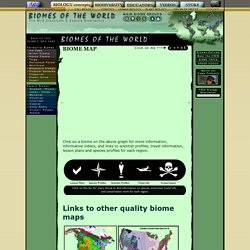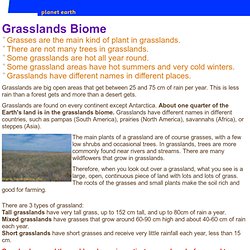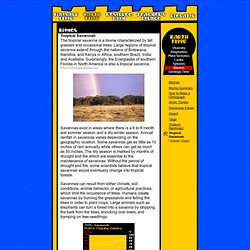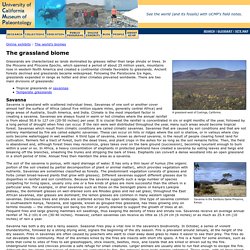

Savannah Video & Map GREEN. Click on a biome on the above graph for more information, informative videos, and links to scientist profiles, travel information, lesson plans and species profiles for each region.

We'd like to know where you're coming from. If you've used this site for a class project or browsing for fun, add yourself to our map and communicate with other "ecogeeks" Grassland Biome. World Biomes - Grassland. Grasslands Biome. Grasslands Biome Grasses are the main kind of plant in grasslands.

There are not many trees in grasslands. Some grasslands are hot all year round. Some grassland areas have hot summers and very cold winters. Grasslands have different names in different places. Grasslands are big open areas that get between 25 and 75 cm of rain per year. Grasslands are found on every continent except Antarctica. The main plants of a grassland are of course grasses, with a few low shrubs and occasional trees. Therefore, when you look out over a grassland, what you see is a large, open, continuous piece of land with lots and lots of grass. There are 3 types of grassland: Tall grasslands have very tall grass, up to 152 cm tall, and up to 80cm of rain a year. Grasslands around the world are becoming extinct as people make farms and towns.
Tropical grasslands are those closest to the equator. Mongolian grassland Grasslands plants and animals Read about some of the world's grasslands: April 2013 copyright © kidcyber. Earth Floor: Savannah Biome. Tropical Savannah The tropical savanna is a biome characterized by tall grasses and occasional trees.

Large regions of tropical savanna extend through the nations of Botswana, Namibia, and Kenya in Africa, southern Brazil, India, and Australia. Surprisingly, the Everglades of southern Florida in North America is also a tropical savanna. Photo © 2000-www.arttoday.com Savannas exist in areas where there is a 6 to 8 month wet summer season and a dry winter season. Annual rainfall in savannas varies depending on the geographic location. Savannas can result from either climate, soil conditions, animal behavior, or agricultural practices, which limit the occurrence of trees. Back | Next. World Biome- Savannah Biome. Grassland Biome. Grassland Biome. Online exhibits : The world's biomes The grassland biome Grasslands are characterized as lands dominated by grasses rather than large shrubs or trees.

In the Miocene and Pliocene Epochs, which spanned a period of about 25 million years, mountains rose in western North America and created a continental climate favorable to grasslands. Ancient forests declined and grasslands became widespread. Following the Pleistocene Ice Ages, grasslands expanded in range as hotter and drier climates prevailed worldwide. Savanna Savanna is grassland with scattered individual trees. The soil of the savanna is porous, with rapid drainage of water. Savanna has both a dry and a rainy season. Other animals (which do not all occur in the same savanna) include giraffes, zebras, buffaloes, kangaroos, mice, moles, gophers, ground squirrels, snakes, worms, termites, beetles, lions, leopards, hyenas, and elephants. Temperate grassland There are also environmental concerns regarding the temperate grasslands. Grasslands Biome. Grassland biomes are large, rolling terrains of grasses, flowers and herbs.

Latitude, soil and local climates for the most part determine what kinds of plants grow in a particular grassland. A grassland is a region where the average annual precipitation is great enough to support grasses, and in some areas a few trees. The precipitation is so eratic that drought and fire prevent large forests from growing. Grasses can survive fires because they grow from the bottom instead of the top. Their stems can grow again after being burned off. When the settlers of the United States moved westward, they found that the grasslands, or prairies as they called them, were more than just dry, flat areas.
There are two different types of grasslands; tall-grass, which are humid and very wet, and short-grass, which are dry, with hotter summers and colder winters than the tall-grass prairie. Grassland biomes can be found in the middle latitudes, in the interiors of continents. By Sam M. 2000 Bibliography: